Are you considering onboarding knowledge management software for your company but don’t know what’s best in the market?
You are not alone.
Businesses are trying to help their employees upgrade their skills and knowledge about their products and services. Recently, they have discovered how beneficial it can be to onboard a knowledge management system for the same.
But what is knowledge management software, and why does your organization need it?
Let’s find out!
Table of Contents
- What is Knowledge Management Software?
- 4 Types of Knowledge Management Systems
- 12 Best Knowledge Management Software for 2024
- Why Your Organization Needs Knowledge Management Software?
- Top 6 Key Features to Search for in Knowledge Management Software
- 6 Benefits of Implementing Knowledge Management Software
What is Knowledge Management Software?
Knowledge management software is a solution that enables businesses to organize all information in one place. This platform allows users to create articles that can be edited, post new updates at any time, and manage other articles in one place, helping businesses create a knowledge repository that can be accessed at any time.
What’s more, businesses can include information about existing products and their functionalities, employee policies, best practices that improve employee productivity, business processes, and much more.
4 Types of Knowledge Management Systems
In this section, we plan to explore the four prominent types of knowledge management systems and how they help businesses achieve different documentation goals.
1. Knowledge Base and Wiki software
A knowledge base and wiki software act like a knowledge library that anyone can refer to in case they have doubts about your products and services. This is like an open library that can be accessed by both your employees and existing customers. If optimized the right way, it can help you gain more MQLs for your business.
2. Document management systems
Want to store all company data in one place? Get yourself a document management system, also known as DMS. It will allow you to create documents from scratch, scan documents, and update them if there are any changes to any company processes. It will also enable you to capture user feedback so they can be upgraded accordingly.
3. Learning management systems
Learning management systems save time and cost on instructors in organizations. You can progress the learning activity of employees in a web-based environment. You can upload all training materials centrally and pride access to employees to their learning hub. You can also track their learning progress, refresh skills and knowledge.
4. Intranet Software
This internal collaboration platform is perfect for companies that would like to share information internally and collaborate with the team seamlessly.. This helps to improve collaboration, store and share company policies and other documents.
12 Best Knowledge Management Software for 2024
Given how knowledge management platforms fulfill the needs of various scenarios, let’s narrow down some of the best options for the same categories. Please note that some of the options listed below already allow their users to create a knowledge management platform that can be used on the intranet.
I. Knowledge Base and Wiki software
1. Document360
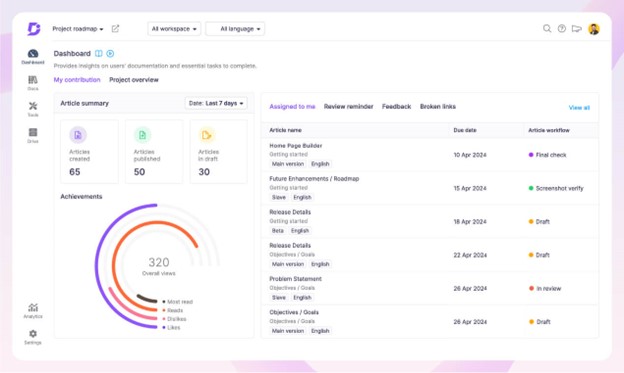
Document360 is your complete knowledge management system powered by AI capabilities. It does everything from advanced search capabilities with Eddy to helping users create content for their KB articles. Moreover, Eddy also understands user queries and provides respective answers with reference articles, which increases efficiency and reduces time.
If this impresses you, wait till you hear the rest. You even get access to built-in Markdown and Advanced WYSIWYG editors help users with no coding experience to master creating technical or support documentation. These editorial features also allow you to add creatives like images, GIFs, videos, and more to make the articles in the knowledge base look more engaging.
Key Features of Document360:
- Create workspaces to appease the requirements of different buyer segments
- Collaborate with in-line comments to ensure only the right information goes online
- Create and use templates to ensure that the same format is being followed throughout all articles
- Add branding through advanced customizations and logos to your knowledge base to be more in line with your brand identity
- Secure all the information stored in your KB with security features like team roles, IP restriction, cookie consent, and others
- Track the performance of every article in analytics and make changes as per the feedback captured on each of them
- Integrate with superior third-party tools like help desk and chat solutions, team collaboration, analytics tools and more
Interested in Document360 Knowledge management software? Schedule a demo with one of our experts
Book A Demo
2. Nuclino
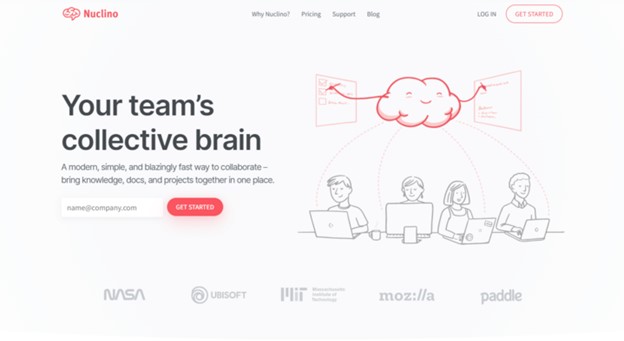
Nuclino is a unified workspace designed for internal knowledge sharing and team collaboration. While Nuclino can be used exclusively as an internal knowledge base, it’s highly versatile. It offers a variety of ways to structure and visualize your content, including a nested list, a Kanban board, and a mind map. This makes it a great solution for many additional use cases, including project management, document collaboration, sprint planning, and more.
Key Features of Nuclino:
- Collaborate in real-time with all the users
- Connect, engage, and get the changes updated Create private workspaces to ensure internal documentation gets accessed by employees only
- Track how every team is offering its inputs for better documentation
- Restrict editing to a few users via comment-only and read-only options
3. ClickUp
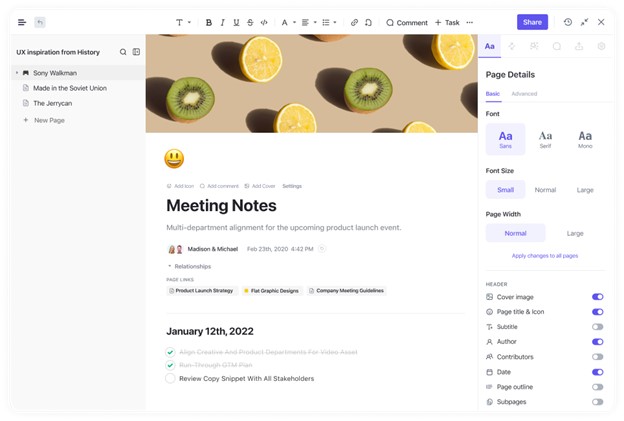
Clickup Docs is the perfect free solution for companies just starting. This free documentation tool allows users to create wikis and internal docs for team access only. From adding tables to formatting the document as you like, Clickup helps you do it all. Moreover, this documentation tool allows you to connect all your docs to workflows, helping you change the status of the content progress as and when it gets written and audited by the team.
Key Features of Clickup:
- Edit documents with your team in real-time
- Drop comments to collaborate the upcoming changes in your wiki
- Link docs and tasks together to stay on top of content production
- Add categories to your docs to help users search for them easily
- Secure all the data in your wiki via privacy and edit controls
4. Uphint

Uphint is a productivity tool designed to streamline documentation, saving time and effort. This tool allows you to cut your way of documenting and bring it to whatever platform you already use, such as Notion, ClickUp, Confluence, Gmail, etc. It transforms any process on your computer into a step-by-step guide in seconds rather than hours. It’s easy to edit and share with any teammate or client.
Key Features of Uphint:
- Break language barriers by creating documentation in your target audience’s language
- Auto-generate brief explanations of your documentation
- Edit articles and screenshots whenever you want
- Add branding to your documentation
- Integrate with third-party solutions to share documentation externally
5. Knowmax
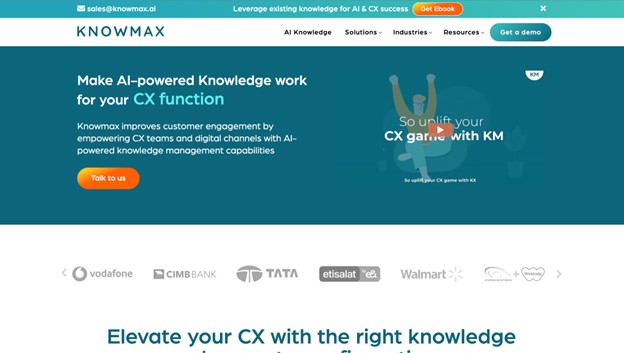
Knowmax is a CX-first Knowledge management software that extends beyond standard articles & FAQs to include dynamic content formats like interactive decision trees & visual how-to-guides. Powered by AI, you can fast track content creation and make your knowledge base authors’ lives easier. Knowmax also integrates seamlessly with your everyday CX tools so your agents have ready access to guided and contextual knowledge within their workflow.
Key Features of Knowmax:
- Add internal links with other documentation articles
- Create detailed guides with images to resolve frequently asked questions
- Upload help articles from your computer
- Embed relevant files and links to the articles
- Upload FAQs in bulk from the existing spreadsheet
6. HelpCrunch

HelpCrunch offers a clean interface designed to scale from the needs of small businesses to large enterprises. It’s an ideal platform for newcomers to customer service management since it also includes a user chat function. For each article, HelpCrunch offers a useful SEO optimization panel where you can add tags and other metadata to each article for better ranking in the search results for each term.
Key Features of HelpCrunch:
- Reach global audience with content translation option
- Use an AI-powered editor to shorten, expand or rephrase existing content
- Add a chat widget to offer real-time support
- Automate self-service by adding FAQ chatbot
- Add smart search to help users find answers faster
II. Document Management System
7. ZOHO Desk
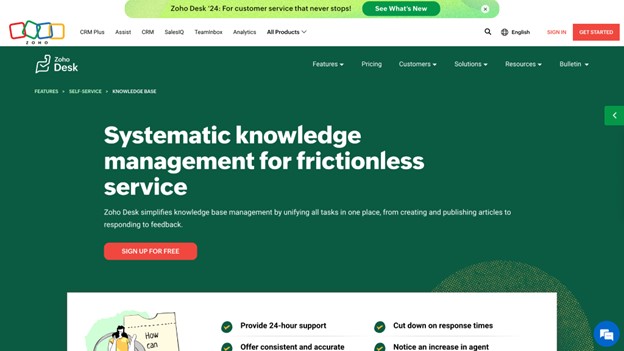
Zoho Desk is another knowledge management software that you must look into when browsing through top options for your business. This solution becomes a centralized repository in two ways. First, it allows you to create a knowledge base for customers and employees to resolve their queries. Second, it helps you maintain a repository for all the creatives used or may be used in the future in the articles. Moreover, you can create documentation for customers in their native language as well.
Key Features of Zoho Desk:
- Collaborate on articles and refine them before publishing
- Optimize articles so they are made visible in search engine
- Make the content creation process transparent by setting user permissions
- Track previous edits and identify which version performed well among users
- Help agents answer questions by integrating it with the ticketing system
8. DocuSign

DocuSign allows you to go paperless and fast track digital agreement progress in real-time. It allows you to get documents signed no matter where you are. It is proactive at sending reminders to users to ensure that no document remains pending at their end and gets signed on time. With the tool, users also get the option to opt for a mobile signature. That means, you can sign and send approved documents anytime, anywhere.
Key Features of DocuSign:
- Sign documents in bulk.
- Set users and assign roles to ensure proper documentation management
- Add custom branding to the documents in seconds
- Track signature history and audit
- Scale the account usage as your business grows
9. Teamwork

Teamwork is a project management solution that allows you to track the entire documentation creation process. It helps you identify the current blockers and allows you to remove them to ensure a seamless completion process of the documents. You can track the first draft to the final draft in the tool and ensure to recover pointers that you’d like to add to the published documentation.
Key Features of Teamwork:
- Set due dates to ensure all the documents are created within a set deadline
- Track recurring tasks and ensure they are dealt with automatically
- View the entire documentation plan and ensure the right resources are working at every stage
- Map the entire documentation project and track how much time it will possibly take to complete it
- Drag and drop priority tasks to ensure timely completion
III. Learning management system
10. Moodle

Moodle, an open-source platform, is a learning management system that allows users to create detailed learning courses for their users. Once you’ve downloaded the tool, you can start creating your course from scratch. The best part is that Moodle keeps all its users updated on what’s next for their product and how users may benefit from the upcoming updates. Their website has a roadmap that allows users to see how they can use Moodle and create courses that will help their employees evolve as skilled labor.
Key Features of Moodle:
- Create instructor-led training courses that employees can follow easily
- Make your courses available 24×7, therefore helping employees learn whenever they have free time
- Create templates that can be managed by people who are assigned certain roles in the course builder software
- Store content and manage it over time by making changes to it as and when the use cases change
- Track the content delivery process to ensure that your courses are being built on time
11. 360Learning
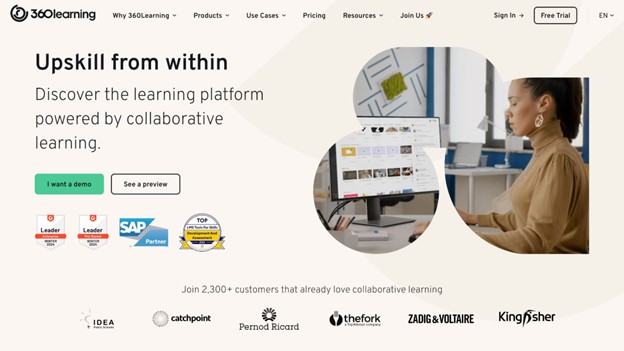
360Learning is another LMS solution that you can use to train your employees and help them upskill whenever the need arises. This tool uses AI to help their users create courses faster. With this solution, you can ensure that compliance training takes place correctly. It can also be used when you are onboarding new employees at the workplace. They can learn about all the policies and the roles and responsibilities they’ll be managing at work.
Key Features of 360Learning:
- Create learning pathways to help employees understand the next set of courses they must take up once they finish an existing one
- Track the content creation process in a step-by-step manner with 360Learning
- Schedule assignments wherever you feel employee knowledge must be tested
- Add short quizzes to keep employees engaged with the course
- Send out certification of completion to employees via email so they can share it on social platforms
12. TalentLMS

TalentLMS is one of the top learning management solutions in the SaaS market. It’s intuitive interface allows its users to create courses that are easy to understand and finish. The solution can be accessed via any device, therefore encouraging employees to finish their courses even when they are on the go. Existing templates and drag-and-drop feature allows users to create courses faster rather than spending months to generate one.
Key Features of TalentLMS:
- Create courses that can help train customers about your products and services
- Create content libraries that can be used when creating courses in the future
- Track content creation progress anytime, anywhere
- Allow employees to finish their courses anytime with 25×7 availability
- Add assessments to ensure that employees have gone through the course properly
Why Does Your Organization Need Knowledge Management Software?
There are multiple reasons your organization needs a knowledge management platform. Here’s a more striking reason why you must invest in this software.
We are no longer living in times where it is feasible for employees to refer to multiple documents placed under different assets. The reason is clear. Such practice leads to losing precious productive hours and failing to gain updated knowledge.
What’s worse, when you have no documents that they can refer to at times, they feel conflicted about the product functionality or even company policies. That’s when they will approach others in the office to get a solution ASAP. Sometimes, the requested person may not be free, and the question may go unanswered for hours or even days.
Sounds tedious, right?
However, with knowledge management software, you can avert these situations and ensure that employees get answers to their questions in real-time and proceed with a solution instantly.
Quick note: Since there are various types of knowledge management software, each will cater to a different organizational need and have a different content flow.
Top 6 Key Features to Search for in Knowledge Management Software
Phew! That was quite a list. But with the options in different categories, you surely need to narrow down the features that will allow you to choose one from the list faster. Don’t worry, we’ve listed the top 6 features you must look for when finalizing your knowledge management software. These include:
1. AI-powered search
AI has entered multiple areas of the SaaS industry, with tools being the primary use case. If your knowledge management software offers an AI-powered search to its users, it will be easier for them to find answers, and they will avoid reaching out to your support team. That means everyone saves time.
2. Easy set up without coding
If your knowledge management option enables you to set up the repository without coding, that’s even better. You will not always require a member from the technical department to complete the setup or even the publishing process of the articles in the knowledge base. This way, you can update the articles whenever you want.
3. Branding and customization
The knowledge management software should also allow you to add branding assets such as images, logos, and even brand themes via an advanced customization option. This way you can ensure that users who land on your help center articles via search engines know more about your brand faster.
4. Backup & restore functionalities
One crucial functionality of a knowledge management platform is its ability to back up and restore content from previous versions. If the option you are considering offers that, don’t hesitate to choose it.
5. Content auditing and editing
Ensure the KMS solution also offers detailed editing functionalities that allow you to add images, GIFS, and videos wherever necessary to explain the how-to guides. Also, check if there is an auditing feature. It would help you track previous documentation versions hassle-free.
6. Easy integration with third-party tools
Do not hesitate if the tool allows you to integrate with third-party tools. Also, check if the integration list includes collaboration solutions, analytics tools, and other CX tools.
6 Benefits of Implementing Knowledge Management Software
With the checklist above, you can choose the best knowledge management software for your business. These are the benefits you will reap from its use.
1. Reduced resolution time
Help the support team reduce resolution time with a knowledge base solution. All they have to do is share the link to relevant articles that help customers resolve their queries faster.
2. Improved training and onboarding
Ensure that all new employees are trained and onboarded with the same material every time. While human training sessions are interactive, you can surely find discrepancies in the way the information is being shared. However, the same is not true when you do it through a knowledge management system. It will be more systematic, and you can ensure that all employees are aware of the same details.
3. Easy management and access to organizational knowledge
Whether they are company policies or access to information about organizational processes, a knowledge management platform can enable you to offer the necessary information to all employees hassle-free. The best part is it can be kept in the intranet so that it can be accessed by employees only.
4. Increased customer satisfaction with self-service
Knowledge management software also helps you elevate customer satisfaction levels in no time. Since information about your products and services can be easily accessed through the knowledge repository, customers can find relevant information that answers their questions about your services faster. That means they don’t have to approach the service team and save their time as well.
5. Breaking down data silos
You can keep your repository updated at all times. The knowledge management system allows you to make changes to your existing articles based on feedback or even their performance among users; therefore, the information never remains stagnant and can be updated whenever necessary.
6. Eases cross-functional knowledge sharing
Help one team share its knowledge with other teams. Knowledge management solutions can allow cross-functional knowledge sharing. You can create a repository on the intranet and encourage all employees to share information about their experiences via articles so that other employees can easily learn more about the product and services.
Wrapping Up
Narrowing one down from multiple knowledge management software options can be challenging. However, our guide helps you understand:
- The types of KMS solutions
- The top options falling under each solution
- The criteria list you must follow to choose one that matches your need
- The benefits you will reap once you onboard the best solution for your business
This detailed guide aims to help you choose the best solution that matches your business’s needs, and we hope you do so in the end. But if you’d like to know more about Document360 as a knowledge management solution, try the free version or book a product demo.
Schedule a demo with one of our experts to take a deeper dive into Document360
Book A Demo
Frequently Asked Questions
-
What is knowledge management and why is it important?
Knowledge management is the process of capturing, storing, sharing, and efficiently managing employees’ knowledge and experience to raise the overall knowledge of the workforce. Its major purpose is to increase efficiency, production, and the retention of essential knowledge within the organization. Accumulating, storing, and efficiently sharing information enables you to establish a culture that can dramatically boost efficiency and employee happiness. However, inadequate knowledge management has a financial impact as well as a negative influence on employee happiness.
-
Key advantage of owning knowledge management software?
Reduce support Cost, Easy access to information, promotes organizational growth & innovation, avoids redundant effort, accelerates customer service, and Keeps track of all documents & other data.
-
What are the four components of knowledge management?
Regardless of your organization’s industry, size, or knowledge requirements, you will always require; people to lead, Knowledge content and IT tools that connect the right people, processes to control & quantify information flows, and strategy for using KM



 –
– 

